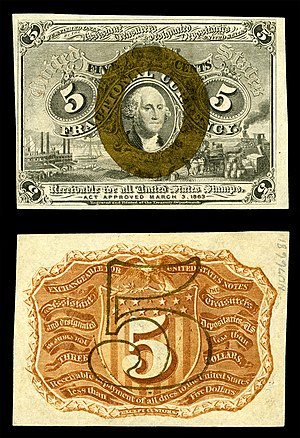Template:POTD/2019-10-10
Appearance
Fractional currency, also referred to as shinplasters, was introduced by the United States federal government following the outbreak of the Civil War. These low-denomination banknotes of the U.S. dollar were in use between 21 August 1862 and 15 February 1876; they were issued in denominations of 3, 5, 10, 15, 25 and 50 cents across five issuing periods. The notes could be redeemed by the U.S. Postal Service for the face value in postage stamps.
This picture shows a second-issue five-cent (5¢) fractional currency note, issued by the United States Department of the Treasury between 1863 and 1867, featuring a portrait of George Washington, the first president of the United States, on the obverse. This note is in the National Numismatic Collection of the Smithsonian Institution's National Museum of American History.
Other denominations: 10¢, 25¢, 50¢Banknote credit: United States Department of the Treasury; photographed by the National Numismatic Collection
This image was chosen at random from a selection of four. ()

